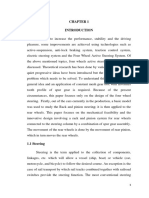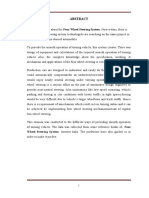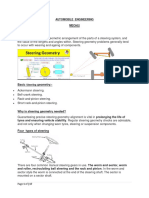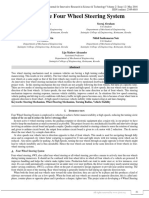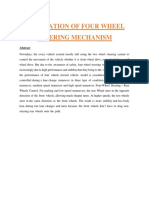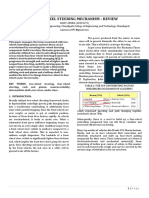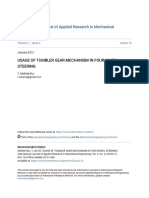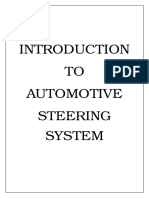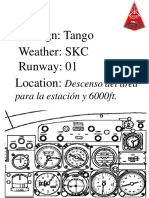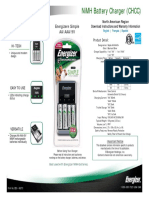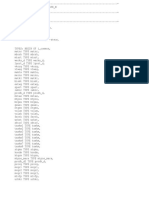An Approach To Parallel Parking and Zero PDF
An Approach To Parallel Parking and Zero PDF
Uploaded by
ajayCopyright:
Available Formats
An Approach To Parallel Parking and Zero PDF
An Approach To Parallel Parking and Zero PDF
Uploaded by
ajayOriginal Title
Copyright
Available Formats
Share this document
Did you find this document useful?
Is this content inappropriate?
Copyright:
Available Formats
An Approach To Parallel Parking and Zero PDF
An Approach To Parallel Parking and Zero PDF
Uploaded by
ajayCopyright:
Available Formats
International Journal For Research & Development in Technology
Volume: 1, Issue: 2, JUNE 2014 ISSN (Online):- 2349-3585
An Approach to Parallel Parking and Zero
Turning Radius in Automobiles
________________________________________________________________________________________________________
Rahul Chandy Philip1, Roshan George Varghese2, Samuel George John3,
Stephen Cherian4, Libin P Oommen5
12345
Mechanical Department, Saintgits College Of Engineering, Kottayam,
Kerala.
Abstract—Conventional steering mechanism involves either "feel". The recirculating ball mechanism is a variation on the
the use of Ackerman or Davis steering systems. The older worm and sector design; the steering column turns a large
disadvantage associated with these systems is the minimum screw (the "worm gear") which meshes with a sector of a gear,
turning radius that is possible for the steering action. This causing it to rotate about its axis as the worm gear is turned; an
difficulty that is associated with the conventional methods of arm attached to the axis of the sector moves the Pitman arm,
steering is eliminated by employing a four wheel steering which is connected to the steering linkage and thus steers the
system. In this system, the wheels connected to the front wheels. At either end of the apparatus the balls exit from
axles are turned opposite to each other, and so are the between the two pieces into a channel internal to the box which
wheels connected to the rear axle. The wheels on the on left connects them with the other end of the apparatus, thus they are
half vehicle rotate in one direction and the ones on the right "recirculated". Power steering assists the driver of an
half of the vehicle rotate in the opposite direction. This automobile in steering by directing a portion of the vehicle's
arrangement of the wheels enables the vehicle to turn 360 power to traverse the axis of one or more of the road wheels.
degrees, without moving from the spot, i.e. the vehicle has As vehicles have become heavier and switched to front wheel
zero turning radius. This helps in maneuvering the vehicle in drive, particularly using negative offset geometry, along with
tight spaces such as parking lots and within small increases in tyre width and diameter, the effort needed to turn
compounds. the steering wheel manually has increased – thus power
Index Terms— Steering mechanism, turning radius, parallel steering systems have been developed. There are two types of
parking power steering systems—hydraulic and electric/electronic. A
hydraulic-electric hybrid system is also possible. An outgrowth
I.INTRODUCTION of power steering is speed adjustable steering, where the
steering is heavily assisted at low speed and lightly assisted at
The various functions of the steering wheel are, to control the high speed.
angular motion the wheels; direction of motion of the vehicle, The most effective type of steering, this type has all the four
to provide directional stability of the vehicle while going wheels of the vehicle used for steering purpose. A detailed
straight ahead, to facilitate straight ahead condition of the description of this type follows.
vehicle after completing a turn , the road irregularities
must be damped to the maximum possible extent. This should
co-exist with the road feel for the driver so that he can feel the II. FOUR WHEEL STEERING
road condition without experiencing the effects of moving over
Contemporary rear axles allows for coincidental steering
it.
through the influence of variation of elasto-kinematic steering;
rear wheels rotate, due to an influence of variation of vertical
A. Types of Steering load of wheels (tilting), in the same direction as front wheels.
Nevertheless, such a turn of rear wheels is very small and
The most frequently used type of steering, are using the front driver‘s will-independent. A disadvantage of this so-called
two wheels of the vehicle. This type of steering suffers from passive steering system is that it operates even when driving in
the comparatively larger turning circle and the extra effort straight direction when single wheel of an axle hits surface
required by the driver to negotiate the turn. Some types of irregularity (deterioration of directional stability). Therefore,
industry battery trucks and industry backhoe loaders use this the active system means that rear wheels are possible to be
type, where only the two rear wheels control the steering. It can turned either coincidently or non-coincidently. The increase of
produce smaller turning circles, but is unsuitable for high speed the maneuverability when parking the vehicle is achieved by
purposes and for ease of use. Many modern cars use rack and means of disconcordant steering, meanwhile the increase of the
pinion steering mechanisms. The rack and pinion design has driving stability at higher speeds is achieved through
the advantages of a large degree of feedback and direct steering concordant steering.
40 Copyright 2014- IJRDT www.ijrdt.org
International Journal For Research & Development in Technology
Volume: 1, Issue: 2, JUNE 2014 ISSN (Online):- 2349-3585
In a typical front wheel steering system, the rear wheels do not III. DESIGN OF FOUR WHEEL STEERING SYSTEM
turn in the direction of the curve, and thus curb on the
It is to be remembered that both the steered wheels do not turn
efficiency of the steering. Normally, this system has not been
in the same direction, since the inner wheels travel by a longer
the preferred choice due to the complexity of conventional
distance than the outer wheels.
mechanical four wheel steering systems. However, a few cars
like the Honda Prelude, Nissan Skyline GT-R have been
A. Ackermann Steering Mechanism
available with four wheel steering systems, where the rear
wheels turn by a small angle to aid the front wheels in steering.
Ackermann steering geometry is a geometric arrangement of
However, these systems had the rear wheels steered by only 2
linkages in the steering of a car or other vehicle designed to
or 3 degrees, as their main aim was to assist the front wheels
solve the problem of wheels on the inside and outside of a turn
rather than steer by themselves.
needing to trace out circles of different radii. The steering pivot
With advances in technology, modern four wheel steering
points are joined by a rigid bar called the tie rod which is also a
systems boast of fully electronic steer-by-wire systems, equal
part of the steering mechanism. With perfect Ackermann, at
steer angles for front and rear wheels, and sensors to monitor
any angle of steering, the centre point of all of the circles traced
the vehicle dynamics and adjust the steer angles in real time.
by all wheels will lie at a common point.
Although such a complex 4WS model has not been created for
Modern cars do not use pure Ackermann steering, partly
production purposes, a number of experimental concepts with
because it ignores important dynamic and compliant effects,
some of these technologies have been built and tested
but the principle is sound for low speed maneuvers, and the
successfully.
right and left wheels do not turn by the same angle, be it any
cornering speed. We chose to use a simple control circuit to
Two modes are generally used in these 4WS models:
demonstrate the effectiveness of a four wheel steering system,
and at the same time, simulated the suspension-steering
A. Slow Speed – Rear Steer Mode
assembly of a typical car to predict the Ackerman angles for
corresponding steer angles. The design calculation for the
At slow speeds, the rear wheels turn in the direction opposite to model follows shortly
the front wheels. This mode becomes particularly useful in case
of pick-up trucks and buses, more so when navigating hilly
B. Condition for True Rolling Motion
regions. It can reduce the turning circle radius by 25% and can
be equally effective in congested city conditions, where U-turns
Perfect steering of the wheels can be achieved only when all
and tight streets are made easier to navigate.
four wheels are rolling perfectly for all dynamic conditions.
While tackling a turn, the condition of perfect rolling motion
will be satisfied if all the four wheel axes when projected at one
B. High Speed point called the instantaneous center, and when the following
equation is satisfied:
In high speeds, turning the rear wheels through an angle
opposite to front wheels might lead to vehicle instability and is cotϕ-cotθ = c⁄b (1)
thus unsuitable. Hence, at speeds above 80 kmph, the rear
wheels are turned in the same direction of front wheels in four-
It is seen that the inside wheel is required to turn through a
wheel steering systems.
greater angle than the outer wheel. The larger the steering
For a typical vehicle, the vehicle speed determining the change
angle, the smaller the turning circle. It has been found that the
of phase has been found to be 80kmph. The steering ratio,
steering angle can have a maximum value of about 44 degrees
however can be changed depending on the effectiveness of the
under dynamic conditions. The extreme positions on either side
rear steering mechanism, and can be as high as 1:1.
are called lock positions. The diameter of the smallest circle
which the outer front wheel of the car can traverse and obtained
Zero Turning Radius – 360 Mode when the wheels are at their extreme positions is known as the
turning circle.
In addition to aforementioned steering types, a new type of four C. Benefits of Four Wheel Steering
wheel steering was introduced by the concept vehicle Jeep
Hurricane, one that could significantly affect the way our With the 3600 mode, the vehicle can quickly turn around at the
vehicles are parked in the future. This vehicle has all three press of a button and a blip of the throttle. Complicated three-
modes of steering described above, though it sports a truly point steering maneuvers and huge space requirements to park
complex drive train and steering layout, with two transfer the vehicle are entirely phased out with this.
cases, to drive the left and right wheels separately. The four
Crab mode helps simplify the lane changing procedure.
wheels have a fully independent steering and need to run in an
In conjunction with rear steer mode, four-wheel steering can
unconventional direction to ensure that the vehicle turns around
significantly improve the vehicle handling at both high and low
on its own axis.
speeds.
Due to the better handling and easier steering capability, driver
fatigue can be reduced even over long drives.
41 Copyright 2014- IJRDT www.ijrdt.org
International Journal For Research & Development in Technology
Volume: 1, Issue: 2, JUNE 2014 ISSN (Online):- 2349-3585
The only major restriction for a vehicle to sport four-wheel
steering is that it should have four or more wheels. Hence,
every kind of private and public transport vehicle, be it cars,
vans, buses, can benefit from this technology.
Military reconnaissance and combat vehicles can benefit to a
great extent from 360 mode, since the steering system can be
purpose built for their application and are of immense help in
navigating difficult terrain.
IV.CONSTRUCTION AND FUNCTION
Fig. 1 Dimensions of Prototype
The main components of a Honda 4WS system are the front
steering gearbox, which turns the front wheels, the rear steering The dimensions of the prototype were measured to be as given
gearbox, which turns the rear wheels, and the center steering below:
shaft, which links the two gearboxes. When the steering wheel
is turned, the front wheels are steered in the same way as with a
2WS system. A rack-and-pinion mechanism in the front Wheelbase = 0.970m
steering gearbox transmits this movement to the rear steering Track-width = 0.970m
gearbox via the center shaft. (The rack-and-pinion mechanism Frame length = 0.900m
is separate from the one to which the steering wheel is Frame width = 0.910m
connected.) Via the rear tie rods, the rear steering gearbox Distance of Instantaneous Centre from rear left wheel
steers the rear wheels by the appropriate angle and in the = 3.78m
appropriate direction.
As evident from the figure, the instantaneous centre falls at the
geometric centre of the prototype, and as a result, the path of
A. Steering Of Rear Wheels the wheels, trace a circular path. The lines produced from the
inclined wheels meet at the centre.
When the steering wheel is turned from its straight-ahead
position by an angle of 120 degree or smaller, the 4WS system The steer angles for the inner and outer wheels during normal
performs to increase in-phase steering of the rear wheels angle. steering operation were also obtained, as seen below in Fig. 2.
When the steering wheel angle exceeds 120 degree, the
rear wheels gradually straighten up then turn in the opposite
direction.
B. Parallel Parking
The car requires just about the same length as itself to park in a
spot. Also since the 3600 mode doesn‘t require steering inputs
the driver can virtually park the vehicle without even touching
the steering wheel. All he has to do is give throttle and brake
inputs, and even they can be automated in modern cars. Hence
such a system can even lead to vehicles that park by Fig. 2 Steer Angles for Inner and Outer Wheels
themselves.
B. Analysis Procedure
The axis of the rear wheels were produced to either side of the
V.DESIGN AND ANALYSIS
vehicle. The steering was then turned to achieve maximum
steer condition, and the axis of the front wheels were produced
A. Line Diagram of the Prototype backwards.
The axis of the front left wheel and the front right wheel met at
A line diagram of the prototype was prepared, as shown in Fig. a point on the rear wheel axis produced towards one side, 3.78
1, which indicates the linear dimensions of the prototype, as m from the left wheel.
well as the instantaneous centre of the body, when the wheels This was obtained while measuring the conformity of the
are inclined in the required position for 360° rotation. steering system with Ackermann‘s condition for stability.
The inner wheel‘s steering angle was measured to be θ =
26.84°, and that of the outer steering wheel as φ = 18.57°.
The stability conditions for the mechanism confirm to
Ackermann‘s conditions.
42 Copyright 2014- IJRDT www.ijrdt.org
International Journal For Research & Development in Technology
Volume: 1, Issue: 2, JUNE 2014 ISSN (Online):- 2349-3585
The average steering angle was calculated as advantage over the normal steering system in terms of time
(φ+ θ) /2 = (18.6+26.8) /2 = 22.7° consumed for the operation. This is more so in the case where
The outer wheel turning radius was calculated as the vehicle is to turn 3600.
√(x²+l²) =√( 3.78²+1.27² ) = 3.98 m And so, from the above values we can say that the 3600 steering
x = distance from point of intersection of front wheels on system is advantageous and saves a nominal amount of time, in
rear wheel axle produced to left rear wheel maneuvering the vehicle in tight spaces, such as parking lots,
l = wheel base of prototype and simplifies the process of parallel parking.
The inner wheel turning radius was calculated as
VI. CONCLUSION
√((x-w)²+l²) =√( (3.78-1.27)²+1.27² ) = 2.81m A vehicle featuring low cost and user friendly steering
w = track width of prototype mechanism has been introduced. This paper focused on a
steering mechanism which offers feasible solutions to a number
C. Proof of Stability of the System of current maneuvering limitations. A prototype for the
proposed approach was developed by introducing separate
The condition for stability of a vehicle having Ackermann mechanism for normal steering purpose and 3600 steering
Steering Mechanism incorporated in it is given by the relation purpose. This prototype was found to be able to be maneuvered
very easily in tight spaces, also making 3600 steering possible.
cotφ-cotθ=w/l
Different mechanisms were adopted by trial and error method,
The w/l ratio of the prototype is 1.27 /1.27 = 1.
in order to facilitate the engagement of the wheels in the
required direction, and the most convenient method was
cot φ-cot θ = cot 18.6-cot 26.8 = 1.000360 adopted.
The time analysis, for the time required to perform a parallel
Thus, we can see from above that the equation parking maneuver and a 3600 turn was carried out, and it was
cotφ-cotθ = w/l is satisfied and hence the prototype is established that the implementation of the modification, led to
stable under Ackermann steering condition. decrease in the time required for the performance of the above
operations.
D. Time Analysis The prototype was tested to ensure the conformity with
Ackermann‘s steering condition, and it complied with the
The time taken for both - 360° steering mechanism and same.
normal steering mechanism for two operations were recorded. The forces acting on each wheel was obtained and the force
The first operation was parallel parking and the second was that required to be applied on the steering wheel, in order to
the turning of the vehicle in 3600. engage the wheels in the required direction was calculated.
The features that enhanced the prototype were the increase in
The obtained readings are as follows: maneuverability in limited space, and the parallel parking
ability. The disadvantages associated with the current prototype
Table 1 were the need to pull two different levers to engage the system,
Time Taken for Time Taken for and the space constraints for incorporating the system.
3600 Mechanism Normal Steering
Mechanism REFERENCES
Parallel Parking 45 seconds 116 seconds
[1] Dr. N. K. Giri, ―Automotive Mechanics‖, Khanna Publishers, 2-
3600 21 seconds 188 seconds B, Nath Market, Nai Sarak, New Delhi – 111006. (1996) , 7th
Edition
[2] Heinz Heisler, ―Advanced Vehicle Technology‖ Second edition.
400 [3] College of technology, PSG, ―Design data – data book of
TIME
350 engineers‖ published by Kalaikathir Achchagam.
300
Normal [4] Rattan S, ―Theory of machines‖, Khanna publications.
System [5] Thomas. D. Gillespie, ―Fundamentals of Vehicle Dynamics‖,
250 Society of Automotive Engineers, Warrendale. (2000) Online
200 360 System Edition
150 [6] (Automobile Engineering), Madras Institute of Technology,
guided by Dr. P.Mannar Jawahar
100 [7] Hiroshi Ohmura (1990) ‗Rear wheel steering apparatus‘, Mazda
50 Motor Corporation, U.S patent No. 4,953,648
0
Parallel Parking 360⁰ Turn
Fig. 3 Time Analysis
As clearly seen from the tabulated values (Table 1) and the
graph (Fig 3), the 360° steering system has considerable
43 Copyright 2014- IJRDT www.ijrdt.org
You might also like
- Linear Circuits: Time Domain, Phasor, and Laplace Transform ApproachesDocument1,126 pagesLinear Circuits: Time Domain, Phasor, and Laplace Transform Approachesromita5biswas100% (1)
- RoommateDocument53 pagesRoommateAditya Kumar100% (1)
- Four Wheel Steering ReportDocument8 pagesFour Wheel Steering Reportvijayan m g100% (12)
- Design and Manufacturing of Gearbox ForDocument11 pagesDesign and Manufacturing of Gearbox ForFred BosmanNo ratings yet
- Ninty Degree SteeringDocument48 pagesNinty Degree Steeringparas bhogulkarNo ratings yet
- 472design and Simulation of Four Wheel Steering System For LMV PDFDocument4 pages472design and Simulation of Four Wheel Steering System For LMV PDFAfzal dawood100% (1)
- Sai Kumar Mini ProjectDocument22 pagesSai Kumar Mini Projectrahulbattini59No ratings yet
- Study of Four Wheel Steering Mechanism: JournalDocument4 pagesStudy of Four Wheel Steering Mechanism: JournalSiva HariNo ratings yet
- Design and Fabrication of Two Modes of Steering FinalDocument38 pagesDesign and Fabrication of Two Modes of Steering FinalS18M168 SUJAN BALAJI SNo ratings yet
- Mechanical Four Wheels SteeringDocument74 pagesMechanical Four Wheels Steeringvijayan m g91% (22)
- Four Wheel SteeringDocument5 pagesFour Wheel SteeringMectrosoft Creative technologyNo ratings yet
- Three Mode Steering System For Light Weight Automobile VehiclesDocument4 pagesThree Mode Steering System For Light Weight Automobile VehiclesKarthik kNo ratings yet
- AE-Module-4 6th Sem.Document17 pagesAE-Module-4 6th Sem.alokkumar216No ratings yet
- SteeringDocument24 pagesSteeringapi-19890903No ratings yet
- Design and Development of Four-Wheel Steering for All Terrain Vehicle (a.T.v)Document10 pagesDesign and Development of Four-Wheel Steering for All Terrain Vehicle (a.T.v)deividbsribeiroNo ratings yet
- Dual Mode Four Wheel Steering System: Sanu Adolphus Sooraj AbrahamDocument7 pagesDual Mode Four Wheel Steering System: Sanu Adolphus Sooraj AbrahamVincent RobinsonNo ratings yet
- Fabrication of Four Wheel Steering MechanismDocument50 pagesFabrication of Four Wheel Steering MechanismMechWindNaniNo ratings yet
- Hydraulic Power Steering System Learning SimulationDocument8 pagesHydraulic Power Steering System Learning SimulationhamayunNo ratings yet
- Four Wheels SteeringDocument18 pagesFour Wheels SteeringArpith KumarNo ratings yet
- Wheel Steering System PDFDocument6 pagesWheel Steering System PDFvivek ghoriNo ratings yet
- Four-Wheel Steering Mechanism - ReviewDocument4 pagesFour-Wheel Steering Mechanism - ReviewRajatNo ratings yet
- Four Wheel Steering System For Future: Research PaperDocument5 pagesFour Wheel Steering System For Future: Research PaperSanket PatilNo ratings yet
- Front Wheel Stearing Moveable HeadlightsDocument42 pagesFront Wheel Stearing Moveable HeadlightsVinoth RamNo ratings yet
- Four Wheel Steering SystemDocument15 pagesFour Wheel Steering Systemjatinshukla4310% (1)
- Dual Axis PPT PNGDocument16 pagesDual Axis PPT PNGrksuhani2912No ratings yet
- Introduction To Automobile: Four Wheel DriveDocument20 pagesIntroduction To Automobile: Four Wheel DriveRavi AnuNo ratings yet
- REPORTDocument36 pagesREPORTAryavart DiplomaNo ratings yet
- Project SynapsisDocument6 pagesProject Synapsisnayan RNo ratings yet
- Steering SystemDocument37 pagesSteering SystemSandeep Magapu100% (1)
- Usage of Tumbler Gear Mechanism in Four Wheel SteeringDocument5 pagesUsage of Tumbler Gear Mechanism in Four Wheel SteeringKitkuparbha MawrieNo ratings yet
- Three Mode Four Wheel Steering-1-1Document15 pagesThree Mode Four Wheel Steering-1-1sree kanthNo ratings yet
- Good Morning .?: Presentation On Vehicle Steering Systems by Pari, D.J & K.CDocument29 pagesGood Morning .?: Presentation On Vehicle Steering Systems by Pari, D.J & K.CSrikar ChinmayaNo ratings yet
- Four Wheel Steering SystemDocument14 pagesFour Wheel Steering SystemChakri KankipatiNo ratings yet
- Four Wheels SteeringDocument19 pagesFour Wheels SteeringBharathNaikPanjaNo ratings yet
- 4 Wheel SteeringDocument5 pages4 Wheel Steeringgurusite1No ratings yet
- Steering SystemsDocument19 pagesSteering SystemsMuneer JaniNo ratings yet
- Four Wheel Drive-SynopsDocument8 pagesFour Wheel Drive-SynopsManoj MalikNo ratings yet
- Usage of Tumbler Gear Mechanism in Four Wheel Steering: T.Saran RajDocument4 pagesUsage of Tumbler Gear Mechanism in Four Wheel Steering: T.Saran RajBHUSHAN BAGDENo ratings yet
- 3 Mode Steering System For 4 WheelersDocument56 pages3 Mode Steering System For 4 WheelersGokul ManikantaNo ratings yet
- 3 Mode SteeringDocument30 pages3 Mode SteeringAnonymous j0aO95fgNo ratings yet
- Steering Mechanism With Zero Turning RadiusDocument19 pagesSteering Mechanism With Zero Turning RadiusAbhay RanjanNo ratings yet
- Power Steering in Automobiles: - Presented byDocument21 pagesPower Steering in Automobiles: - Presented byKarthik KardekerNo ratings yet
- Presentation ON " 4WS " System: Neeraj Gautam (07ME026)Document27 pagesPresentation ON " 4WS " System: Neeraj Gautam (07ME026)Neeraj GautamNo ratings yet
- Four Wheel Steering SystemDocument26 pagesFour Wheel Steering SystemRavindra Singh RathoreNo ratings yet
- Four Wheel Steering System DocumentDocument20 pagesFour Wheel Steering System DocumentBala comfortNo ratings yet
- Four Wheel Steering ReportDocument8 pagesFour Wheel Steering ReportPradyumna Keshari NahakNo ratings yet
- Development of Four Wheel Steering SysteDocument8 pagesDevelopment of Four Wheel Steering Syste吴善统No ratings yet
- 4-Wheel Steering MechanismDocument15 pages4-Wheel Steering MechanismMohseen KarcheNo ratings yet
- Steering SystemDocument12 pagesSteering Systemmayur_lanjewarNo ratings yet
- Ijcrt22a6502 Rack PinonDocument9 pagesIjcrt22a6502 Rack PinonenkusilasorsaNo ratings yet
- 360 Degree Load CarrierDocument28 pages360 Degree Load CarrierTanviNo ratings yet
- TO Automotive Steering SystemDocument22 pagesTO Automotive Steering SystemJ Naveen KumarNo ratings yet
- Four Wheel Steering SystemDocument12 pagesFour Wheel Steering Systemvijayan m gNo ratings yet
- Four Wheel, Three Mode Steering System - 3Document9 pagesFour Wheel, Three Mode Steering System - 3Tejzas Parab100% (1)
- Visvesvaraya Technological University: "Jnanasangama", BelgaviDocument30 pagesVisvesvaraya Technological University: "Jnanasangama", Belgavigurusite1No ratings yet
- Steering FinalDocument7 pagesSteering FinalMayur PanchalNo ratings yet
- Chassis InformationDocument11 pagesChassis InformationManny AnacletoNo ratings yet
- Four WheelDocument14 pagesFour WheelMaheshNo ratings yet
- 258 266, Tesma602, IJEASTDocument9 pages258 266, Tesma602, IJEASTgurusite1No ratings yet
- Advanced Four Wheel Steering SystemDocument5 pagesAdvanced Four Wheel Steering SystemSyedAbuBakar'sAlkaffNo ratings yet
- BhelDocument20 pagesBheljiveshiamkingNo ratings yet
- Datasheet 80011877Document9 pagesDatasheet 80011877LuigiRussoNo ratings yet
- Boldface t37Document4 pagesBoldface t37Sebastian Riaño CNo ratings yet
- Nimh Battery Charger (CHCC) : Product DatasheetDocument1 pageNimh Battery Charger (CHCC) : Product Datasheetjeffreygovender5745No ratings yet
- Designing Buildings For Fire Safety BS 9999: 2008 Code of Practice For Fire Safety in The Design, Management and Use of BuildingsDocument39 pagesDesigning Buildings For Fire Safety BS 9999: 2008 Code of Practice For Fire Safety in The Design, Management and Use of BuildingsMarvvv100% (1)
- Atlantic Supplies Company Profile 2023Document74 pagesAtlantic Supplies Company Profile 2023vlinemubeenNo ratings yet
- MAZATROL FUSION 640M ALARM LIST - Mazak 640M Alarm ListDocument88 pagesMAZATROL FUSION 640M ALARM LIST - Mazak 640M Alarm Listkrzysiekochalek14No ratings yet
- Ve Diy StrobeDocument5 pagesVe Diy Strobeasa2034No ratings yet
- Root File SystemDocument2 pagesRoot File Systemtiwari anupamNo ratings yet
- Is.14785.2000 - Coast Down Test PDFDocument12 pagesIs.14785.2000 - Coast Down Test PDFVenkata NarayanaNo ratings yet
- Liquid Adhesive Gun LS-T 373: Manual P/N 7135973B EnglishDocument56 pagesLiquid Adhesive Gun LS-T 373: Manual P/N 7135973B EnglishPandel LucianNo ratings yet
- Heating VentilatingDocument127 pagesHeating VentilatingMukhammadjonNo ratings yet
- Multilayer Chip Capacitors X7R/B Characteristic: FeaturesDocument17 pagesMultilayer Chip Capacitors X7R/B Characteristic: FeaturesLupita Motta TobíasNo ratings yet
- Wa0002.Document2 pagesWa0002.Good VibesNo ratings yet
- Preliminary Design of Precipitated Silica PlantDocument13 pagesPreliminary Design of Precipitated Silica PlantAmelia SafitriNo ratings yet
- Zbapi Mat Create WDocument68 pagesZbapi Mat Create Wwaseem27_1No ratings yet
- APS-3 With FIELDGenius v1.01Document74 pagesAPS-3 With FIELDGenius v1.01Diyan Purnama PutraNo ratings yet
- 07017-0014-023-EN-03 - D20003 FAdC MaintenanceDocument13 pages07017-0014-023-EN-03 - D20003 FAdC Maintenancevishu4urNo ratings yet
- Jet Filter GBDocument6 pagesJet Filter GBBrian WebbNo ratings yet
- Boiler Turbine Generator: Unit Trip Report-Draft STPP, 2X600 MWDocument5 pagesBoiler Turbine Generator: Unit Trip Report-Draft STPP, 2X600 MWVishal Kumar Laddha100% (1)
- Analysis of An Intermediate Rear Axle Shaft Failure: January 2015Document4 pagesAnalysis of An Intermediate Rear Axle Shaft Failure: January 2015Ranjodh SinghNo ratings yet
- Composite Manufacturing 101Document84 pagesComposite Manufacturing 101veljko100% (1)
- HUT-A Hydraulic Universal Testing Machine 2018.6.26 PDFDocument6 pagesHUT-A Hydraulic Universal Testing Machine 2018.6.26 PDFSoup PongsakornNo ratings yet
- Sharp XL Hf102bDocument44 pagesSharp XL Hf102bboroda2410No ratings yet
- Exhibitor Manual ETBFSI CIO Digital ConclaveDocument8 pagesExhibitor Manual ETBFSI CIO Digital Conclavekaran.shah1No ratings yet
- Java 8 Tips DocumentationDocument89 pagesJava 8 Tips DocumentationdlkfaNo ratings yet
- Geobag River DibangDocument6 pagesGeobag River DibangPalak ShivhareNo ratings yet
- Cleaning Fuel Injector NozzlesDocument6 pagesCleaning Fuel Injector NozzlesRay DutchmanNo ratings yet








